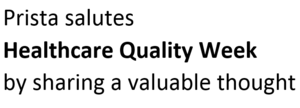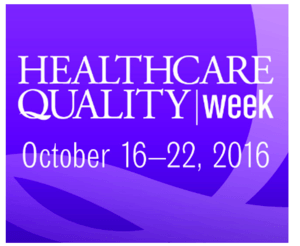National Healthcare Quality Week
As a contribution to the celebration of all of those who work diligently and passionately in Healthcare Quality, we would like to plant a seed of thought, an innovative vision, of pursuing the goals of Quality (and its intimate partner, Safety) to get better outcomes, more consistently, while using less effort and cost, and feeling less frustration. In other words, an easier path to improvement.Historically, “Quality” has been tightly associated with “reporting” and it may be understandably difficult for many to separate their thinking in that regard from the collection and manipulation of data, research on and calculation of Performance Measures, visual analysis of number grids and graphs, generating and compiling reports, and sitting though hours of review meetings to share and discuss the information. And much of the effort in Quality reporting targets higher level management and especially external parties, rather than the clinical staff themselves. Many describe such responsibilities as overly mechanical and time-consuming, seriously reducing the time and brain power left over for the cognitive work of imagining, planning and confirming improvement in healthcare delivery. Even highly-respected overt methodologies, which supposedly serve that improvement goal, often add to the mechanical effort requiring procedural education, special forms, jargon, and more meetings.To a great degree, much of that is accepted, personally and organizationally, as being “the Quality job”, but perhaps there is vision of something different. A breakthrough.
The reason we talk about a breakthrough is important. There is a very strong tendency, while trying to improve processes, to simple tweak the same activities and artifacts that have been part of the process for a long time. That is definitely the case with quality. If we focus on the cognitive path, from observation to improvement, and design optimally for the digital/electronic medium to support that, then real progress can be made. This must not be equated to having users take on the mindset, language or skills of “techies”. It should be the case that the power of technology and especially the design expertise that is coupled to it, is delivered into the operative “space” of the targeted users.
When that is done well, much of the mechanics, physical activities and artifacts can be eliminated and the most precious resource of the clinical staff – their professional intellectual capabilities – are channeled toward the improvement goal. To put that in tangible terms, this vision is about one place where all the information involved in the Performance Measures of Quality Management, in Safety Event reporting and investigation, and in the Action Plans for Performance Improvement exist in intuitive, connected, workflows. The net effect is a design that radically reduces both labor and mental exertion to get actionable insights.
Realizing such a vision may be challenging because of departmental, process, policy and political barriers, the natural inhibitors of fear, ego and comfort, and the tyranny of time and money invested in the “old ways”. But why should you or your organization let those stand in the way of your passion to pursue Quality the way you’ve always known it should be done?
Taking the Blinders Off to Find Good HC IT Products
 |
If I write something on a piece of paper and put it into a file cabinet, I can go back and retrieve it whenever I want it. This is how most healthcare information systems work. It is really important, and pretty challenging, but it is also long past time that healthcare executives and buyers of healthcare IT demand far more for their (millions of) dollars. This limited input/store/retrieve model is as outdated as punch cards. |
A user of such an outdated system can’t ask a complex or developmental question and receive a refined answer, nor request analysis to enhance understanding or knowledge. With a giant digital file cabinet, it’s up to the human to do all the complex tasks and analyses—often a time consuming and possibly error-prone undertaking.
The workaround for healthcare delivery organizations is the hiring of data analysts to work between clinical managers and the system. This ignores and exacerbates two really big problems: the Total Cost of Ownership (TCO) for the solution, which is seldom discussed frankly (or remembered from previous experiences); and the delay and disjointedness in the workflow of clinical and senior management in trying to gain insight and make decisions.
Users should demand that the systems they use automatically process information rather than just store it. They need simple and fast access to insights that are understood and anticipated by system designers. They need what they get out of the system to be of higher value than what they put in. And, as much as anything, clinical experts and managers should not have to turn into technical data analysts, or work through them, to do their own jobs.
It should come as no surprise that the key to incorporating more complex abilities resides in the system design. A well-designed system could be instrumental in transforming the processes and culture of the entire enterprise, simply by the way it works and the way in which users interface with it.
System designers’ involving users is the right thing to do. However, as in many things, the critical part is in how and how well one does the right thing. When software developers follow the input of hands-on users verbatim, the results are frequently disappointing and almost always lacking in innovation. Users should inform the design process about their environment and objectives, about what insights will help them do their jobs better. They should not be the final word on how forms should be laid out or data presented, because there is a tendency to recreate the past in terms of paper forms and the processes built around them. This will only bring inefficiencies from previous systems into the current one; it may look familiar on screen, but it’s not going to be the powerful analytical asset that it could be.
To be of most value, system design needs to take the whole enterprise into account. It must consider processes and workflows that cross departments and functions, how the technology can do as much mechanical stuff for users as possible, make navigation and workflow intuitive, and chain together steps that make up users’ typical working functions. This takes a more holistic, flowing and comprehensive view than the more linear and choppy collection of tasks that many software developers tend to take. And it takes a little art thrown in with the science to figure out how to organize and analyze the information that gets put into the system so that the most people get the best use of its useful, insightful finished products.
System design must move beyond the “giant file cabinet” paradigm in order to achieve a better solution. The good news is that many software companies are doing just that, and we will see very positive outcomes as more and more hospitals move beyond simple input-storage-retrieval and use technology to enhance understanding and insight.
Alliance with CIHQ
Prista Corporation and the Center for Improvement in Healthcare Quality (CIHQ) Collaborate to Enhance Patient Safety

About the Collaboration
Prista and CIHQ are driving for the same goal – to radically improve the effectiveness and efficiency of quality-safety* efforts in healthcare delivery organizations. While the organizations differ in services and approach, their philosophies related to providing education, resources and tools to the healthcare community are well aligned.
Through a variety of communication vehicles, CIHQ provides education, shares perspectives on patient safety and compliance, and presents available resources and tools. Through its ActionCue Clinical Intelligence online application, Prista enables subscribers to significantly reduce and streamline the mechanics and manual data manipulation of the improvement processes for quality-safety.
Billie Anne Schoppman, Chief Mission Officer at Prista reflects “CIHQ is innovative, nimble and responsive just like Prista and makes a great partner to really help care providers break through some stasis and inertia to put best practices to work and drive quality and safety improvement like never before – effectively, efficiently and consistently.”
Rick Curtis, Chief Executive Officer of CIHQ, explains his perspective; “We’re excited to partner with Prista. Both our organizations share a common Mission and purpose. Our partnership will enable Prista clients to access our vast array of web-based support services, and our clients will benefit from access to Prista’s innovative quality and patient safety management platform. It’s not just a win/win for both companies, it’s a win/win for our respective clients.”
Be on the lookout for lots of content and opportunities to participate in demonstrations to learn how Prista’s ActionCue platform and CIHQ’s education, advice and content go hand-in-hand to advance our joint subscribers and members to the forefront of America’s healthcare organizations.
* – Quality-safety reflects Prista’s position that care quality and safety for patients are inseparable and should naturally be addressed together in an integrated improvement–centered management process.

About CIHQ
The Center for Improvement in Healthcare Quality (CIHQ) is a membership-based organization comprised of over 300 acute care and critical access hospitals across the United States. Member organizations enjoy a comprehensive program of web-based and other support services designed to help them be successful in their accreditation and certification compliance efforts. CIHQ is also recognized as a deeming-authority by CMS for acute care and long-term acute care hospitals.
About Prista
Prista provides the ActionCue® Clinical Intelligence online application, a very innovative platform integrating Quality Management, Event Reporting and Investigation, and Performance Improvement functionality. Beyond a dashboard or reporting tool, ActionCue provides a complete work environment for staff, management and executives to obtain immediate insights into all clinical issues and what is being done to improve them, to own and drive the improvement-centered quality-safety process as never before.
Goodbye Hamster Wheel, Hello Common Sense
Patient care quality and safety improvements happen on the job, not in meeting rooms. Yet the quest for improvement in many hospitals today takes place in classrooms, where the focus is more on the methodology than on patients and the delivery of care. Furthermore, the intense methodologies are too often a giant step backward for staff in terms of productive, time-efficient use of information.
The need to improve patient care quality and safety has been an item on the hospital executive agenda since the 1999 publication of “To Err is Human: Building a Safer Health System” by the Institute of Medicine. There has been some improvement over the past 16 years: The Hospital Consumer Assessment of Healthcare Providers and Systems (HCAHPS) summary report shows some increase in overall hospital rating across the whole U.S. from 64 out of 100 in 2007 to 71 out of 100 in 2013 and 2014 (71 out of 100), with results for part of 2015 remaining at 71.
Judging by the large number of high-cost consultant engagements by hospitals across the country, quality and safety improvements are still high priorities for hospitals. Additionally, there seems to be an assumption in the executive suite that management and staff don’t have the ability to improve patient care quality and safety themselves, that there must be something added in terms of knowledge, skills or processes that will end up producing the desired results.
Each consultancy claiming a specialty in this area has a proprietary approach, a methodology or a process (or all three) for getting staff on the right track. The focus is on cognitive behavior change and the communication of concepts and values that staff need to assimilate into their work routines. Staff must leave their daily work to attend seminars or take classes that are meant to improve patients’ perception of the in-hospital experience. The activities that are part of these methodologies do not incorporate technology as a useful or time-saving tool. If anything, they prevent staff from implementing technology that really could make the difference the hospital seeks.
In spite of sizable investment of money and staff time in the various methodologies offered by consultants to improve quality and safety, the HCAHPS score has not significantly changed over the past few years. More importantly, the scores of actual clinical performance have similarly changed little. Yet the consultants are still going strong. Why? Most likely because once a company has invested significant resources in a third party methodology, it wants to stick it out in order to get a return. If it’s not working, the perceived solution often is to dedicate more resources to add further services. This produces a “hamster wheel” situation where, whether things are working or not, the company continues to retain the consultancy for more, better and different solutions and continues to take staff away from the very activities that could make the desired improvements.
The way for a hospital to see significant and sustained improvement in patient care quality and safety is to get off the hamster wheel. Rather than writing big checks to companies that take the staff off the floor and that focus on a return to paper management and on changing what is in the heads of the staff, hospital executives need to invest in ways to consistently provide staff with the up-to-date, easily accessed, high-value information – knowledge and insight, as opposed to basic data. This enables the staff to make the best decisions for their patients—every day.
Cut losses, stop spending more money on third party “solutions” that involve more work hours you have to pay for (and that aren’t working) and put common sense into play. Keep the staff out on the floor and give them technology, training and modern processes that infuse quality and safety into every activity, task and patient interaction.
CEO Brings ActionCue to Pecos County Memorial Hospital




